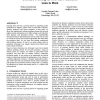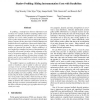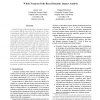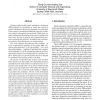7 search results - page 1 / 2 » Software Profiling for Hot Path Prediction: Less is More |
ASPLOS
2000
ACM
13 years 8 months ago
2000
ACM
Recently, there has been a growing interest in exploiting profile information in adaptive systems such as just-in-time compilers, dynamic optimizers and, binary translators. In th...
CGO
2007
IEEE
13 years 8 months ago
2007
IEEE
In profiling, a tradeoff exists between information and overhead. For example, hardware-sampling profilers incur negligible overhead, but the information they collect is consequen...
ICSE
2009
IEEE-ACM
14 years 5 months ago
2009
IEEE-ACM
A variety of compilers, static analyses, and testing frameworks rely heavily on path frequency information. Uses for such information range from optimizing transformations to bug ...
ICSE
2003
IEEE-ACM
14 years 4 months ago
2003
IEEE-ACM
Impact analysis, determining when a change in one part of a program affects other parts of the program, is timeconsuming and problematic. Impact analysis is rarely used to predict...
CGO
2003
IEEE
13 years 8 months ago
2003
IEEE
Existing profile-guided partial redundancy elimination (PRE) methods use speculation to enable the removal of partial redundancies along more frequently executed paths at the expe...




